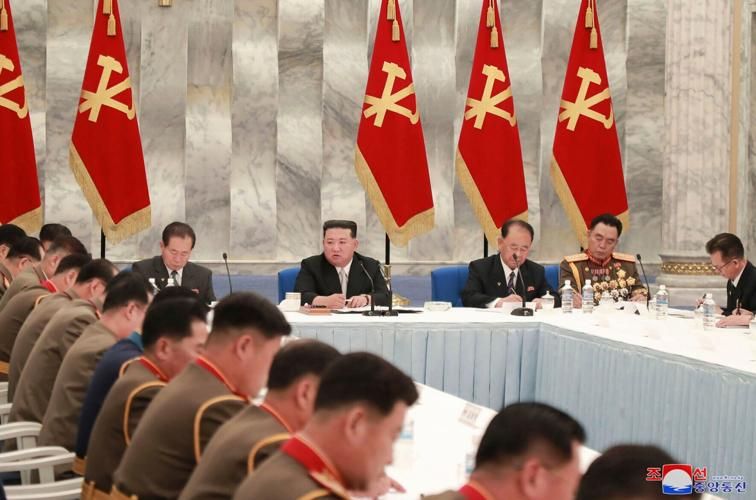At a crucial conference, military authorities authorised undisclosed additional operational responsibilities for frontline army units. During this summit, North Korean leader Kim Jong Un doubled down on his efforts to build up nuclear weapons in order to overwhelm enemy troops.
According to reports that surfaced on Friday in the state-run media, members of the Central Military Commission of the ruling Workers’ Party came to the conclusion that it was necessary to amend an important military action plan regarding the responsibilities of frontline troops and further bolster the nation’s nuclear war deterrent.
North Korea has not detailed the new operational tasks for frontline army units; nevertheless, observers believe the nation may be aiming to deploy battlefield nuclear weapons along their tense border with South Korea, which is their adversary.
While the majority of the international community is focused on North Korea’s efforts to develop nuclear-capable ballistic missiles that have the range to strike the continental United States, the country is also working on a variety of nuclear-capable short-range missiles that are designed to strike South Korea. The language surrounding such missiles, according to the opinions of several experts, conveys a threat to proactively employ them in combat in order to counteract the more powerful conventional forces held by South Korea and the United States. In order to prevent attack from the North, the United States has around 28,500 soldiers stationed in the South.
Kim called for his entire army to go all out in carrying out the plans to bolster the nation’s military muscle and consolidate powerful self-defense capabilities for overwhelming any hostile forces and thus reliably protecting the dignity of the great country. The meeting of the military commission lasted for three days and ended on Thursday.
According to the official Korean Central News Agency of North Korea, the commission’s members reviewed measures to enhance the party’s leadership over the whole of the armed forces and endorsed proposals for changes in the organisational structures of the military that were not mentioned.
As the country’s nuclear-capable weapons have been managed by the army’s strategic force up until this point, some analysts believe that North Korea’s possible plans to deploy tactical nuclear weapons to frontline artillery units may require changes to the command-and-control structure of the country’s armed forces.
The meeting took place amidst growing indications that North Korea is getting ready to carry out its first nuclear test explosion since September 2017. The North Korean government has maintained that it is capable of carrying out nuclear attacks on the United States.
North Korea may use its next nuclear test to claim that it has acquired the ability to build a small nuclear warhead that can fit its short-range missiles or other weapons that it recently tested, including a purported hypersonic missile and a long-range cruise missile, according to experts. North Korea may also use its next nuclear test to claim that it has acquired the ability to build a nuclear bomb that can fit inside of a suitcase. The North’s declared goal of developing a multiple-warhead intercontinental ballistic missile (ICBM) would also need smaller warheads.
Even though nuclear test preparations were not mentioned in the North Korean accounts of the meeting, a representative for the South Korean government said that Seoul is keeping a careful eye on any developments relating to this topic.
According to North Korea, significant plans to expand and strengthen its war deterrent have been discussed and ratified. In light of this information, (our) government will prepare for all possibilities while carefully monitoring related trends, according to Cha Duck-chul, who works in the Unification Ministry in Seoul, which is responsible for handling inter-Korean affairs.
North Korea has already established a new year record for ballistic testing during the first half of 2022, shooting over 30 missiles. These launches include the country’s first tests involving intercontinental ballistic missiles in almost five years.
Since April, when Kim supervised a test of a new short-range missile that state media said would drastically improve the firepower of frontline artillery units and enhance the efficiency in the operation of tactical nukes, it has been predicted that North Korea will push to deploy battlefield nuclear weapons at frontline units. This was predicted after Kim supervised the test of a new short-range missile.
According to the opinions of several experts, the extremely rapid speed at which North Korea conducted its nuclear tests this year demonstrates Kim Jong-twin un’s intention to both expand his arsenal and exert pressure on the United States government about the long-stalled nuclear negotiations. Since the beginning of 2019, there has been a standstill in the talks due to disputes on the exchange of the easing of punishing sanctions led by the United States against the North and the North’s disarmament efforts.
Kim has not shown any inclination to completely hand up an arsenal, which he views as his best possible assurance of surviving. According to the opinions of several analysts, the goal of his campaign of exerting pressure is to coerce the United States into recognising North Korea as a nuclear state so that he may negotiate economic and security concessions from a position of strength.
